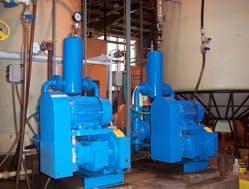Pesticides, floor waxes, emulsifiers, disinfectants were stored, mixed and packaged there until 1983 when a number of questionable disposal practices ultimately lead to the plant’s closing. Testing of the groundwater revealed high levels of arsenic and volatile organic compounds.
The U.S. Environmental Protection Agency administered a remedial investigation that eventually earned the site a ranking of 14th on the National Priorities List.
Further studies concluded that the best strategy for groundwater treatment would be long term, on-site pump and treat technology.
Contaminated groundwater is extracted from eight wells strategically placed throughout the site, with various depths ranging up to 80 ft. Eight multi-staged centrifugal pumps transfer the groundwater to an equalization tank at an average rate of approximately 130 gpm, 24 hours/day.
Metals removal is accomplished by chemical treatment for coagulation, followed by flocculation & sedimentation of the resultant solids.
Sedimentation is achieved with a lamella clarifier and the resultant sludge is thickened and dewatered with a plate and frame filter press to greater than 35% solids, then trucked to an approved offsite landfill.
Two Abel HMD-G-12-0060 high pressure, filter press feed pumps are piped in parallel for redundancy during this critical phase of the process. The HM series pump was chosen over other style pumps for its durability in handling abrasive and gritty slurry at high pressures.
Each pump can deliver 27 gpm up to 230 psi and are controlled by a variable frequency drive to reduce energy costs.
These pumps are available in simplex single or double acting design. In addition to the attributes of piston membrane pumps such as self-priming and the ability to run dry, the pumps are characterized by high volumetric efficiency, wear resistance and their flexibility for varying filter press applications.
For over three years these pumps continue to run reliably with minimal service and downtime.


